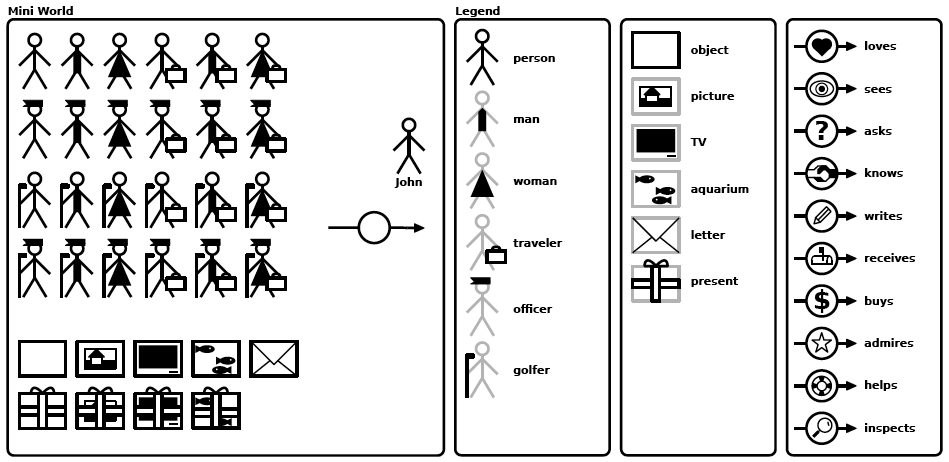Ontograph Framework
Tobias Kuhn, 15 October 2010
Table of Contents
This document contains resources for the ontograph framework. The ontograph framework is an experiment framework to test the understandability of controlled natural languages and other usability oriented formal languages.
The complete content of this page (including the pictures in the different formats) can be reused freely under the terms of the Creative Commons Attribution License. Click on the icon below for more information. In an experimental setting, the attribution can be dropped.

The following publications describe the ontograph framework:
[3]
Tobias Kuhn.
Controlled English for Knowledge Representation.
Doctoral thesis, Faculty of Economics, Business Administration and Information Technology of the University of Zurich, 2010.
[2]
Tobias Kuhn.
An Evaluation Framework for Controlled Natural Languages.
In Norbert E. Fuchs, editor, Proceedings of the Workshop on Controlled Natural Language (CNL 2009), Lecture Notes in Computer Science 5972, pages 1-20.
Springer, 2010.
[1]
Tobias Kuhn.
How to Evaluate Controlled Natural Languages.
In Pre-Proceedings of the Workshop on Controlled Natural Language (CNL 2009),
CEUR Workshop Proceedings, Volume 448, 2009.
Below, a kit is shown that can be used to create ontographs. Furthermore, exemplary ontographs and statements (plus some additional material) are shown that have been used for two experiments.
The ontograph kit shown below contains the graphical elements out of which ontographs can be created.
The four ontographs shown below (1X, 2X, 3X and 4X) have been used for the experiment described in [1]. Each ontograph has two series of statements (a and b) each of which consists of 10 statements in ACE ("Attempto Controlled English"). Only series a has been used for the experiment described in the paper. Some of the statement are true and have a plus sign (+) in the identifier. The others are false and their identifiers have a minus sign (−).
| Ontograph (png, pdf, odg) |
Statements |
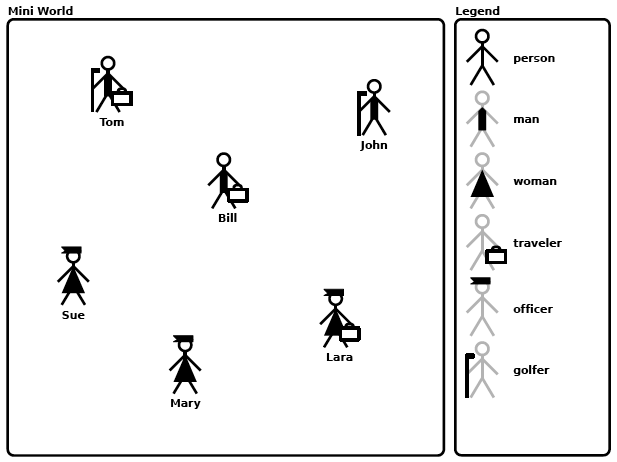 |
| ID |
ACE |
| 1a− |
Mary is a traveler. |
| 1b+ |
John is a golfer. |
| 2a+ |
Bill is not a golfer. |
| 2b− |
Lara is not an officer. |
| 3a+ |
Mary is an officer or is a woman. |
| 3b− |
John is a woman or is a traveler. |
| 4a− |
Sue is an officer and is a traveler. |
| 4b+ |
Tom is a man and is a golfer. |
| 5a− |
Every traveler is a man. |
| 5b+ |
Every officer is a woman. |
| 6a+ |
No golfer is a woman. |
| 6b− |
No traveler is a golfer. |
| 7a+ |
Every woman is an officer and every officer is a woman. |
| 7b− |
Every golfer is a man and every man is a golfer. |
| 8a− |
Every traveler who is not a woman is a golfer. |
| 8b+ |
Every man who is not a golfer is a traveler. |
| 9a+ |
Every man is a golfer or is a traveler. |
| 9b− |
Every traveler is a golfer or is an officer. |
| 10a+ |
Every woman who is a golfer is a traveler. |
| 10b+ |
Every officer who is a man is a golfer. |
|
| Ontograph (png, pdf, odg) |
Statements |
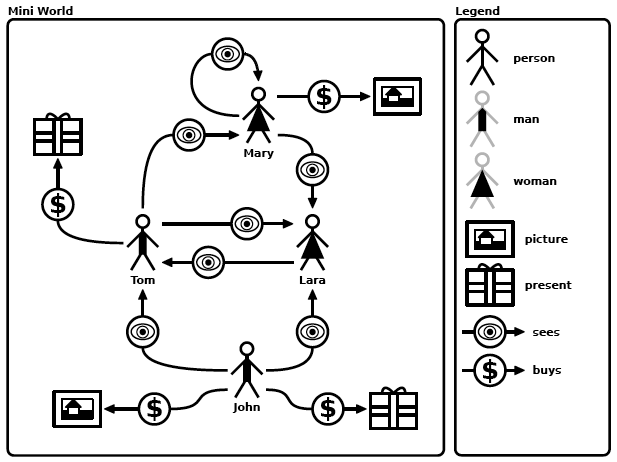 |
| ID |
ACE |
| 1a+ |
John sees Tom. |
| 1b− |
Lara sees Mary. |
| 2a+ |
Mary does not see Tom. |
| 2b− |
Tom does not see Lara. |
| 3a− |
Tom buys a picture. |
| 3b+ |
John buys a present. |
| 4a− |
John sees no woman. |
| 4b+ |
Mary sees no man. |
| 5a+ |
Tom sees every woman. |
| 5b− |
Lara sees every man. |
| 6a+ |
Tom sees nothing but women. |
| 6b− |
John sees nothing but men. |
| 7a+ |
Lara buys nothing but presents. |
| 7b+ |
Lara buys nothing but pictures. |
| 8a− |
No woman sees herself. |
| 8b+ |
No man sees himself. |
| 9a+ |
Every woman buys nothing but pictures. |
| 9b− |
Every man buys nothing but presents. |
| 10a+ |
No man who buys a picture is seen by a woman. |
| 10b− |
No woman who buys a picture is seen by a man. |
|
| Ontograph (png, pdf, odg) |
Statements |
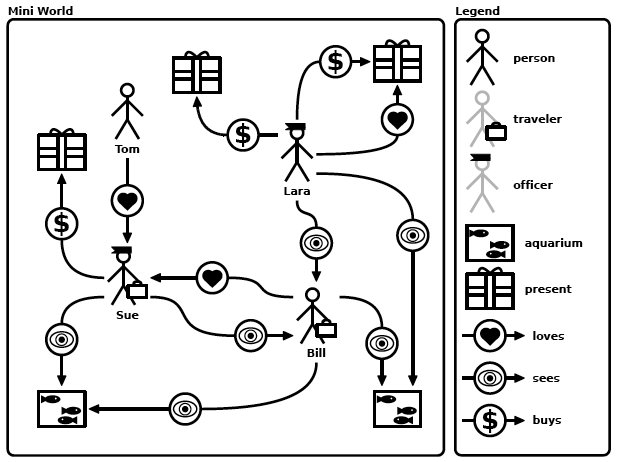 |
| ID |
ACE |
| 1a+ |
Everything that loves something is a person. |
| 1b− |
Everything that sees something is an officer. |
| 2a− |
Everything that is loved by something is a person. |
| 2b+ |
Everything that is bought by something is a present. |
| 3a+ |
Everything that sees something is an officer or is a traveler. |
| 3b− |
Everything that loves something is a traveler or is an officer. |
| 4a− |
Everything that is bought by something is an aquarium or is an officer. |
| 4b+ |
Everything that is seen by something is a traveler or is an aquarium. |
| 5a− |
Everything buys at most 1 thing. |
| 5b+ |
Everything loves at most 1 thing. |
| 6a+ |
Everything is bought by at most 1 thing. |
| 6b− |
Everything is loved by at most 1 thing. |
| 7a− |
Lara sees at least 2 persons. |
| 7b+ |
Bill sees at least 2 aquariums. |
| 8a+ |
Bill is seen by at most 1 traveler. |
| 8b− |
Sue is loved by at most 1 person. |
| 9a− |
Every officer is loved by at least 2 persons. |
| 9b+ |
Every aquarium is seen by at least 2 persons. |
| 10a+ |
Every officer sees exactly 1 traveler. |
| 10b− |
Every traveler loves exactly 1 person. |
|
| Ontograph (png, pdf, odg) |
Statements |
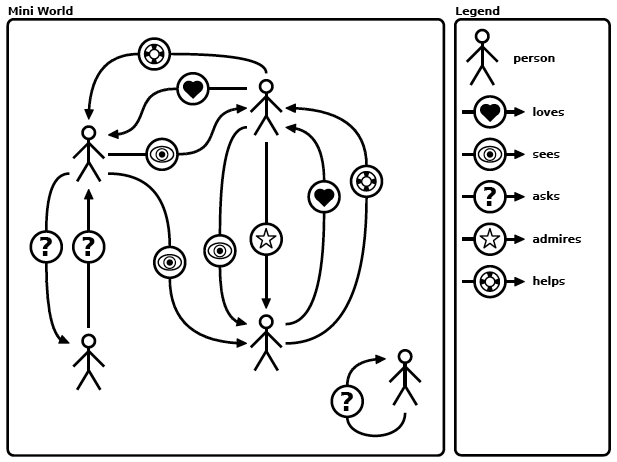 |
| ID |
ACE |
| 1a+ |
If X asks Y then Y asks X. |
| 1b− |
If X helps Y then Y helps X. |
| 2a+ |
If X sees Y then Y does not see X. |
| 2b− |
If X asks Y then Y does not ask X. |
| 3a− |
Nothing asks itself. |
| 3b+ |
Nothing sees itself. |
| 4a− |
If X loves something that loves Y then X loves Y. |
| 4b+ |
If X sees something that sees Y then X sees Y. |
| 5a+ |
If X admires Y then X sees Y. |
| 5b− |
If X sees Y then X admires Y. |
| 6a− |
If X helps Y then Y admires X. |
| 6b+ |
If X loves Y then Y sees X. |
| 7a− |
If X admires Y then X does not see Y. |
| 7b+ |
If X loves Y then X does not admire Y. |
| 8a+ |
If X admires Y then Y does not see X. |
| 8b− |
If X sees Y then Y does not love X. |
| 9a− |
If X admires Y then X sees Y. If X sees Y then X admires Y. |
| 9b+ |
If X loves Y then X helps Y. If X helps Y then X loves Y. |
| 10a+ |
If X sees something that admires Y then X sees Y. |
| 10b− |
If X asks something that sees Y then X asks Y. |
|
The examples shown here have been used for a second ontograph experiment. The goal was to compare the controlled natural language ACE ("Attempto Controlled English") to a common formal language, i.e. MLL. MLL stands for "Manchester-like language" and is a language heavily inspired by the Manchester Syntax for OWL. See [2] and [3] for the details.
Below, four series of ontographs (1, 2, 3 and 4) are shown, each consisting of three ontographs (A, B and C). Each ontograph has two series of statements (a and b) each of which consists of 10 statements. These statements are built according to certain patterns, and each statement is expressed in ACE and in MLL. Some of the statement are true and have a plus sign (+) in the identifier. The others are false and their identifiers have a minus sign (–). The ontographs B and C of each series and the respective statements are structurally equivalent in the sense that they can be derived from each other by one-to-one replacements of the names of the individuals, types and relations.
The participants of the experiment received a printed language description sheet for ACE and another one for MLL. Because these description sheets only describe the subset of the language that was used for the given series, each series has its own description sheets. For the sake of neutrality, ACE was called "language A" and MLL was called "language B". German and English versions of the descriptions sheets are available.
At the end, the questionnaire is shown that the participants had to fill out after the experiment.
The statements of this series only contain individuals and types, but no relations. These are the used language description sheets:
- ACE Description, English (pdf, odt)
- ACE Description, German (pdf, odt)
- MLL Description, English (pdf, odt)
- MLL Description, German (pdf, odt)
The following table shows the sentence patterns of Series 1:
| ID |
Name |
ACE Pattern |
MLL Pattern |
| 1 |
individual type |
[I] is a [T]. |
[I] HasType [T] |
| 2 |
negative individual type |
[I] is not a [T]. |
[I] HasType not [T] |
| 3 |
disjunctive individual type |
[I] is a [T1] or is a [T2]. |
[I] HasType [T1] or [T2] |
| 4 |
conjunctive individual type |
[I] is a [T1] and is a [T2]. |
[I] HasType [T1] and [T2] |
| 5 |
subtype |
Every [T1] is a [T2]. |
[T1] SubTypeOf [T2] |
| 6 |
disjoint types |
No [T1] is a [T2]. |
[T1] DisjointWith [T2] |
| 7 |
equivalent types |
Every [T1] is a [T2] and every [T2] is a [T1]. |
[T1] EquivalentTo [T2] |
| 8 |
complex subtype |
Every [T1] who is not a [T2] is a [T3]. |
[T1] and (not [T2]) SubTypeOf [T3] |
| 9 |
complex supertype |
Every [T1] is a [T2] or is a [T3]. |
[T1] SubTypeOf [T2] or [T3] |
| 10 |
complex subtype/supertype |
Nobody who is a [T1] or who is a [T2] is a [T3] and is a [T4]. |
[T1] or [T2] SubTypeOf not ([T3] and [T4]) |
| Ontograph (png, pdf, odg) |
Statements |
 |
| ID |
ACE |
MLL |
| 1a− |
Mary is a traveler. |
Mary HasType traveler |
| 1b+ |
John is a golfer. |
John HasType golfer |
| 2a+ |
Bill is not a golfer. |
Bill HasType not golfer |
| 2b− |
Lisa is not an officer. |
Lisa HasType not officer |
| 3a+ |
Mary is an officer or is a golfer. |
Mary HasType officer or golfer |
| 3b− |
John is a woman or is a traveler. |
John HasType woman or traveler |
| 4a− |
Sue is an officer and is a traveler. |
Sue HasType officer and traveler |
| 4b+ |
Tom is a man and is a golfer. |
Tom HasType man and golfer |
| 5a− |
Every man is a golfer. |
man SubTypeOf golfer |
| 5b+ |
Every golfer is a man. |
golfer SubTypeOf man |
| 6a+ |
No golfer is a woman. |
golfer DisjointWith woman |
| 6b− |
No traveler is a golfer. |
traveler DisjointWith golfer |
| 7a+ |
Every woman is an officer and every officer is a woman. |
woman EquivalentTo officer |
| 7b− |
Every golfer is a man and every man is a golfer. |
golfer EquivalentTo man |
| 8a− |
Every traveler who is not a woman is a golfer. |
traveler and (not woman) SubTypeOf golfer |
| 8b+ |
Every man who is not a golfer is a traveler. |
man and (not golfer) SubTypeOf traveler |
| 9a+ |
Every man is a golfer or is a traveler. |
man SubTypeOf golfer or traveler |
| 9b− |
Every traveler is a golfer or is an officer. |
traveler SubTypeOf golfer or officer |
| 10a+ |
Nobody who is a man or who is a golfer is an officer and is a traveler. |
man or golfer SubTypeOf not (officer and traveler) |
| 10b− |
Nobody who is a traveler or who is an officer is a man and is a golfer. |
traveler or officer SubTypeOf not (man and golfer) |
|
This ontograph and its statements are structurally equivalent to 1C.
| Ontograph (png, pdf, odg) |
Statements |
 |
| ID |
ACE |
MLL |
| 1a+ |
John is a traveler. |
John HasType traveler |
| 1b− |
Mary is a traveler. |
Mary HasType traveler |
| 2a− |
Bill is not an officer. |
Bill HasType not officer |
| 2b+ |
Sue is not an officer. |
Sue HasType not officer |
| 3a− |
Tom is an officer or is a golfer. |
Tom HasType officer or golfer |
| 3b+ |
Paul is a golfer or is a man. |
Paul HasType golfer or man |
| 4a− |
Mary is a woman and is a traveler. |
Mary HasType woman and traveler |
| 4b+ |
John is a man and is a traveler. |
John HasType man and traveler |
| 5a− |
Every man is a traveler. |
man SubTypeOf traveler |
| 5b+ |
Every traveler is a man. |
traveler SubTypeOf man |
| 6a+ |
No traveler is a golfer. |
traveler DisjointWith golfer |
| 6b− |
No officer is a woman. |
officer DisjointWith woman |
| 7a+ |
Every woman is a golfer and every golfer is a woman. |
woman EquivalentTo golfer |
| 7b− |
Every traveler is a man and every man is a traveler. |
traveler EquivalentTo man |
| 8a− |
Every officer who is not a traveler is a golfer. |
officer and (not traveler) SubTypeOf golfer |
| 8b+ |
Every man who is not a traveler is an officer. |
man and (not traveler) SubTypeOf officer |
| 9a+ |
Every man is a traveler or is an officer. |
man SubTypeOf traveler or officer |
| 9b− |
Every officer is a man or is a traveler. |
officer SubTypeOf man or traveler |
| 10a− |
Nobody who is a golfer or who is a traveler is a man and is an officer. |
golfer or traveler SubTypeOf not (man and officer) |
| 10b+ |
Nobody who is a man or who is a traveler is an officer and is a golfer. |
man or traveler SubTypeOf not (officer and golfer) |
|
This ontograph and its statements are structurally equivalent to 1B.
| Ontograph (png, pdf, odg) |
Statements |
 |
| ID |
ACE |
MLL |
| 1a+ |
Lisa is an officer. |
Lisa HasType officer |
| 1b− |
Bill is an officer. |
Bill HasType officer |
| 2a− |
Sue is not a golfer. |
Sue HasType not golfer |
| 2b+ |
Tom is not a golfer. |
Tom HasType not golfer |
| 3a− |
Mary is a golfer or is a traveler. |
Mary HasType golfer or traveler |
| 3b+ |
Kate is a traveler or is a woman. |
Kate HasType traveler or woman |
| 4a− |
Bill is a man and is an officer. |
Bill HasType man and officer |
| 4b+ |
Lisa is a woman and is an officer. |
Lisa HasType woman and officer |
| 5a− |
Every woman is an officer. |
woman SubTypeOf officer |
| 5b+ |
Every officer is a woman. |
officer SubTypeOf woman |
| 6a+ |
No officer is a traveler. |
officer DisjointWith traveler |
| 6b− |
No golfer is a man. |
golfer DisjointWith man |
| 7a+ |
Every man is a traveler and every traveler is a man. |
man EquivalentTo traveler |
| 7b− |
Every officer is a woman and every woman is an officer. |
officer EquivalentTo woman |
| 8a− |
Every golfer who is not an officer is a traveler. |
golfer and (not officer) SubTypeOf traveler |
| 8b+ |
Every woman who is not an officer is a golfer. |
woman and (not officer) SubTypeOf golfer |
| 9a+ |
Every woman is an officer or is a golfer. |
woman SubTypeOf officer or golfer |
| 9b− |
Every golfer is a woman or is an officer. |
golfer SubTypeOf woman or officer |
| 10a− |
Nobody who is a traveler or who is an officer is a woman and is a golfer. |
traveler or officer SubTypeOf not (woman and golfer) |
| 10b+ |
Nobody who is a woman or who is an officer is a golfer and is a traveler. |
woman or officer SubTypeOf not (golfer and traveler) |
|
The statements of this series contain relations with different kinds of simple quantifications. These are the used language description sheets:
- ACE Description, English (pdf, odt)
- ACE Description, German (pdf, odt)
- MLL Description, English (pdf, odt)
- MLL Description, German (pdf, odt)
The following table shows the sentence patterns of Series 2:
| ID |
Name |
ACE Pattern |
MLL Pattern |
| 1 |
relation instance |
[I1] [R] [I2]. |
[I1] [R] [I2] |
| 2 |
negative relation instance |
[I1] does not [R] [I2]. |
[I1] not [R] [I2] |
| 3 |
concrete existential statement |
[I] [R] a [T]. |
[I] HasType [R] some [T] |
| 4 |
concrete negative statement 1 |
[I] [R] no [T]. |
[I] HasType not ([R] some [T]) |
| 5 |
concrete negative statement 2 |
[I] [R] something that is not a [T]. |
[I] HasType [R] some (not [T]) |
| 6 |
concrete exception statement |
[I] [R] nothing but [T]. |
[I] HasType [R] only [T] |
| 7 |
general existential statement 1 |
Every [T1] [R] a [T2]. |
[T1] SubTypeOf [R] some [T2] |
| 8 |
general existential statement 2 |
Everything that [R] a [T1] is a [T2]. |
[R] some [T1] SubTypeOf [T2] |
| 9 |
general exception statement 1 |
Every [T1] [R] nothing but [T2]. |
[T1] SubTypeOf [R] only [T2] |
| 10 |
general exception statement 2 |
Everything that [R] nothing but [T1] is a [T2]. |
[R] only [T1] SubTypeOf [T2] |
| Ontograph (png, pdf, odg) |
Statements |
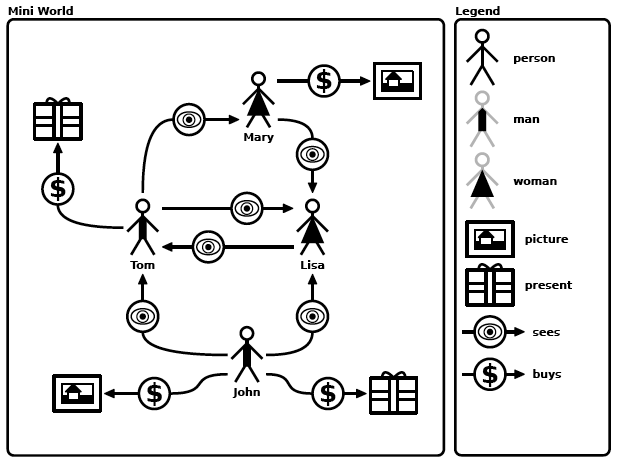 |
| ID |
ACE |
MLL |
| 1a− |
Lisa sees Mary. |
Lisa sees Mary |
| 1b+ |
John sees Tom. |
John sees Tom |
| 2a+ |
Mary does not see Tom. |
Mary not sees Tom |
| 2b− |
Tom does not see Lisa. |
Tom not sees Lisa |
| 3a− |
Tom buys a picture. |
Tom HasType buys some picture |
| 3b+ |
John buys a present. |
John HasType buys some present |
| 4a+ |
Mary sees no man. |
Mary HasType not (sees some man) |
| 4b− |
John sees no woman. |
John HasType not (sees some woman) |
| 5a+ |
John buys something that is not a present. |
John HasType buys some (not present) |
| 5b− |
Tom sees something that is not a woman. |
Tom HasType sees some (not woman) |
| 6a− |
John sees nothing but men. |
John HasType sees only man |
| 6b+ |
Tom sees nothing but women. |
Tom HasType sees only woman |
| 7a+ |
Every man buys a present. |
man SubTypeOf buys some present |
| 7b− |
Every woman buys a picture. |
woman SubTypeOf buys some picture |
| 8a+ |
Everything that buys a present is a man. |
buys some present SubTypeOf man |
| 8b− |
Everything that sees a woman is a man. |
sees some woman SubTypeOf man |
| 9a− |
Every man buys nothing but presents. |
man SubTypeOf buys only present |
| 9b+ |
Every woman buys nothing but pictures. |
woman SubTypeOf buys only picture |
| 10a+ |
Everything that buys nothing but pictures is a woman. |
buys only picture SubTypeOf woman |
| 10b− |
Everything that sees nothing but women is a man. |
sees only woman SubTypeOf man |
|
This ontograph and its statements are structurally equivalent to 2C.
| Ontograph (png, pdf, odg) |
Statements |
 |
| ID |
ACE |
MLL |
| 1a− |
Tom inspects Lisa. |
Tom inspects Lisa |
| 1b+ |
Lisa inspects Tom. |
Lisa inspects Tom |
| 2a+ |
Lisa does not admire Tom. |
Lisa not admires Tom |
| 2b− |
Tom does not admire Lisa. |
Tom not admires Lisa |
| 3a+ |
Lisa admires an officer. |
Lisa HasType admires some officer |
| 3b− |
Lisa admires a traveler. |
Lisa HasType admires some traveler |
| 4a+ |
Paul admires no officer. |
Paul HasType not (admires some officer) |
| 4b− |
Lisa inspects no traveler. |
Lisa HasType not (inspects some traveler) |
| 5a+ |
Sue admires something that is not a traveler. |
Sue HasType admires some (not traveler) |
| 5b− |
Paul admires something that is not an aquarium. |
Paul HasType admires some (not aquarium) |
| 6a+ |
Tom inspects nothing but letters. |
Tom HasType inspects only letter |
| 6b− |
Lisa inspects nothing but travelers. |
Lisa HasType inspects only traveler |
| 7a− |
Every traveler inspects a letter. |
traveler SubTypeOf inspects some letter |
| 7b+ |
Every officer inspects an aquarium. |
officer SubTypeOf inspects some aquarium |
| 8a+ |
Everything that inspects an aquarium is an officer. |
inspects some aquarium SubTypeOf officer |
| 8b− |
Everything that admires a person is an officer. |
admires some person SubTypeOf officer |
| 9a− |
Every officer inspects nothing but aquariums. |
officer SubTypeOf inspects only aquarium |
| 9b+ |
Every traveler admires nothing but officers. |
traveler SubTypeOf admires only officer |
| 10a− |
Everything that admires nothing but persons is an officer. |
admires only person SubTypeOf officer |
| 10b+ |
Everything that inspects nothing but letters is a traveler. |
inspects only letter SubTypeOf traveler |
|
This ontograph and its statements are structurally equivalent to 2B.
| Ontograph (png, pdf, odg) |
Statements |
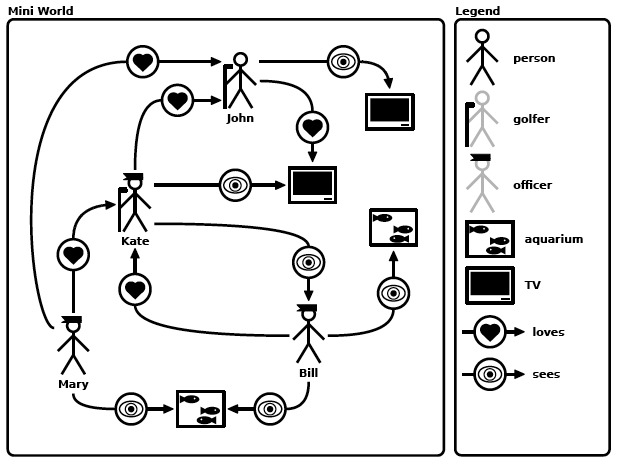 |
| ID |
ACE |
MLL |
| 1a− |
Bill sees Kate. |
Bill sees Kate |
| 1b+ |
Kate sees Bill. |
Kate sees Bill |
| 2a+ |
Kate does not love Bill. |
Kate not loves Bill |
| 2b− |
Bill does not love Kate. |
Bill not loves Kate |
| 3a+ |
Kate loves a golfer. |
Kate HasType loves some golfer |
| 3b− |
Kate loves an officer. |
Kate HasType loves some officer |
| 4a+ |
John loves no golfer. |
John HasType not (loves some golfer) |
| 4b− |
Kate sees no officer. |
Kate HasType not (sees some officer) |
| 5a+ |
Mary loves something that is not an officer. |
Mary HasType loves some (not officer) |
| 5b− |
John loves something that is not a TV. |
John HasType loves some (not TV) |
| 6a+ |
Bill sees nothing but aquariums. |
Bill HasType sees only aquarium |
| 6b− |
Kate sees nothing but officers. |
Kate HasType sees only officer |
| 7a− |
Every officer sees an aquarium. |
officer SubTypeOf sees some aquarium |
| 7b+ |
Every golfer sees a TV. |
golfer SubTypeOf sees some TV |
| 8a+ |
Everything that sees a TV is a golfer. |
sees some TV SubTypeOf golfer |
| 8b− |
Everything that loves a person is a golfer. |
loves some person SubTypeOf golfer |
| 9a− |
Every golfer sees nothing but TVs. |
golfer SubTypeOf sees only TV |
| 9b+ |
Every officer loves nothing but golfers. |
officer SubTypeOf loves only golfer |
| 10a− |
Everything that loves nothing but persons is a golfer. |
loves only person SubTypeOf golfer |
| 10b+ |
Everything that sees nothing but aquariums is an officer. |
sees only aquarium SubTypeOf officer |
|
The statements of this series consist of domain, range, and cardinality restrictions. These are the used language description sheets:
- ACE Description, English (pdf, odt)
- ACE Description, German (pdf, odt)
- MLL Description, English (pdf, odt)
- MLL Description, German (pdf, odt)
The following table shows the sentence patterns of Series 3:
| ID |
Name |
ACE Pattern |
MLL Pattern |
| 1 |
domain |
Everything that [R] something is a [T]. |
[R] HasDomain [T] |
| 2 |
range |
Everything that is [R] by something is a [T]. |
[R] HasRange [T] |
| 3 |
complex domain |
Everything that [R] something is a [T1] or is a [T2]. |
[R] HasDomain [T1] or [T2] |
| 4 |
complex range |
Everything that is [R] by something is a [T1] or is a [T2]. |
[R] HasRange [T1] or [T2] |
| 5 |
minimal cardinality |
[I] [R] at least 2 [T]. |
[I] HasType [R] min 2 [T] |
| 6 |
maximal cardinality |
[I] [R] at most 1 [T]. |
[I] HasType [R] max 1 [T] |
| 7 |
general minimal cardinality 1 |
Every [T1] [R] at least 2 [T2]. |
[T1] SubTypeOf [R] min 2 [T2] |
| 8 |
general minimal cardinality 2 |
Everything that [R] at least 2 [T1] is a [T2]. |
[R] min 2 [T1] SubTypeOf [T2] |
| 9 |
general maximal cardinality |
Every [T1] [R] at most 1 [T2]. |
[T1] SubTypeOf [R] max 1 [T2] |
| 10 |
complex maximal cardinality |
Everything that is a [T1] or that is a [T2] [R] at most 1 [T3]. |
[T1] or [T2] SubTypeOf [R] max 1 [T3] |
| Ontograph (png, pdf, odg) |
Statements |
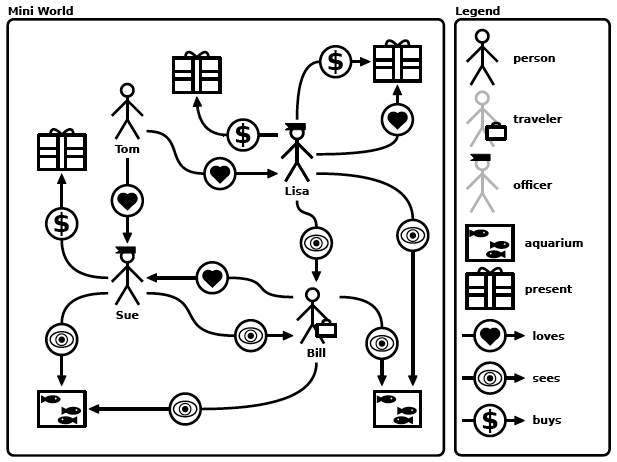 |
| ID |
ACE |
MLL |
| 1a− |
Everything that sees something is an officer. |
sees HasDomain officer |
| 1b+ |
Everything that loves something is a person. |
loves HasDomain person |
| 2a− |
Everything that is loved by something is a person. |
loves HasRange person |
| 2b+ |
Everything that is bought by something is a present. |
buys HasRange present |
| 3a− |
Everything that loves something is a traveler or is an officer. |
loves HasDomain traveler or officer |
| 3b+ |
Everything that sees something is an officer or is a traveler. |
sees HasDomain officer or traveler |
| 4a+ |
Everything that is seen by something is a traveler or is an aquarium. |
sees HasRange traveler or aquarium |
| 4b− |
Everything that is bought by something is an aquarium or is an officer. |
buys HasRange aquarium or officer |
| 5a+ |
Tom loves at least 2 officers. |
Tom HasType loves min 2 officer |
| 5b− |
Sue sees at least 2 persons. |
Sue HasType sees min 2 person |
| 6a− |
Lisa buys at most 1 present. |
Lisa HasType buys max 1 present |
| 6b+ |
Bill loves at most 1 person. |
Bill HasType loves max 1 person |
| 7a+ |
Every traveler sees at least 2 aquariums. |
traveler SubTypeOf sees min 2 aquarium |
| 7b− |
Every officer buys at least 2 presents. |
officer SubTypeOf buys min 2 present |
| 8a+ |
Everything that buys at least 2 presents is an officer. |
buys min 2 present SubTypeOf officer |
| 8b− |
Everything that loves at least 2 officers is a traveler. |
love min 2 officer SubTypeOf traveler |
| 9a+ |
Every officer sees at most 1 aquarium. |
officer SubTypeOf sees max 1 aquarium |
| 9b− |
Every person buys at most 1 present. |
person SubTypeOf buys max 1 present |
| 10a− |
Everything that is a traveler or that is an officer sees at most 1 aquarium. |
traveler or officer SubTypeOf sees max 1 aquarium |
| 10b+ |
Everything that is an officer or that is a traveler loves at most 1 person. |
officer or traveler SubTypeOf loves max 1 person |
|
This ontograph and its statements are structurally equivalent to 3C.
| Ontograph (png, pdf, odg) |
Statements |
 |
| ID |
ACE |
MLL |
| 1a− |
Everything that inspects something is an officer. |
inspects HasDomain officer |
| 1b+ |
Everything that helps something is an officer. |
helps HasDomain officer |
| 2a+ |
Everything that is inspected by something is a letter. |
inspects HasRange letter |
| 2b− |
Everything that is seen by something is an officer. |
sees HasRange officer |
| 3a+ |
Everything that inspects something is a golfer or is an officer. |
inspects HasDomain golfer or officer |
| 3b− |
Everything that sees something is an officer or is a golfer. |
sees HasDomain officer or golfer |
| 4a+ |
Everything that is seen by something is an officer or is a picture. |
sees HasRange officer or picture |
| 4b− |
Everything that is helped by something is a golfer or is an officer. |
helps HasRange golfer or officer |
| 5a+ |
Lisa inspects at least 2 letters. |
Lisa HasType inspects min 2 letter |
| 5b− |
Paul sees at least 2 persons. |
Paul HasType sees min 2 person |
| 6a− |
Lisa helps at most 1 person. |
Lisa HasType helps max 1 person |
| 6b+ |
John sees at most 1 officer. |
John HasType sees max 1 officer |
| 7a+ |
Every officer helps at least 2 persons. |
officer SubTypeOf helps min 2 person |
| 7b− |
Every officer inspects at least 2 letters. |
officer SubTypeOf inspects min 2 letter |
| 8a− |
Everything that sees at least 2 pictures is an officer. |
sees min 2 picture SubTypeOf officer |
| 8b+ |
Everything that inspects at least 2 letters is an officer. |
inspects min 2 letter SubTypeOf officer |
| 9a− |
Every person inspects at most 1 letter. |
person SubTypeOf inspects max 1 letter |
| 9b+ |
Every person helps at most 1 officer. |
person SubTypeOf helps max 1 officer |
| 10a+ |
Everything that is an officer or that is a golfer sees at most 1 picture. |
officer or golfer SubTypeOf sees max 1 picture |
| 10b− |
Everything that is a golfer or that is an officer inspects at most 1 letter. |
golfer or officer SubTypeOf inspects max 1 letter |
|
This ontograph and its statements are structurally equivalent to 3B.
| Ontograph (png, pdf, odg) |
Statements |
 |
| ID |
ACE |
MLL |
| 1a− |
Everything that sees something is a golfer. |
sees HasDomain golfer |
| 1b+ |
Everything that helps something is a golfer. |
helps HasDomain golfer |
| 2a+ |
Everything that is seen by something is a TV. |
sees HasRange TV |
| 2b− |
Everything that is admired by something is a golfer. |
admires HasRange golfer |
| 3a+ |
Everything that sees something is a traveler or is a golfer. |
sees HasDomain traveler or golfer |
| 3b− |
Everything that admires something is a golfer or is a traveler. |
admires HasDomain golfer or traveler |
| 4a+ |
Everything that is admired by something is a golfer or is a present. |
admires HasRange golfer or present |
| 4b− |
Everything that is helped by something is a traveler or is a golfer. |
helps HasRange traveler or golfer |
| 5a+ |
Kate sees at least 2 TVs. |
Kate HasType sees min 2 TV |
| 5b− |
Mary admires at least 2 persons. |
Mary HasType admires min 2 person |
| 6a− |
Kate helps at most 1 person. |
Kate HasType helps max 1 person |
| 6b+ |
Bill admires at most 1 golfer. |
Bill HasType admires max 1 golfer |
| 7a+ |
Every golfer helps at least 2 persons. |
golfer SubTypeOf helps min 2 person |
| 7b− |
Every golfer sees at least 2 TVs. |
golfer SubTypeOf sees min 2 TV |
| 8a− |
Everything that admires at least 2 presents is a golfer. |
admires min 2 present SubTypeOf golfer |
| 8b+ |
Everything that sees at least 2 TVs is a golfer. |
sees min 2 TV SubTypeOf golfer |
| 9a− |
Every person sees at most 1 TV. |
person SubTypeOf sees max 1 TV |
| 9b+ |
Every person helps at most 1 golfer. |
person SubTypeOf helps max 1 golfer |
| 10a+ |
Everything that is a golfer or that is a traveler admires at most 1 present. |
golfer or traveler SubTypeOf admires max 1 present |
| 10b− |
Everything that is a traveler or that is a golfer sees at most 1 TV. |
traveler or golfer SubTypeOf sees max 1 TV |
|
The statements of this series are only about relations and not about individuals or types. These are the used language description sheets:
- ACE Description, English (pdf, odt)
- ACE Description, German (pdf, odt)
- MLL Description, English (pdf, odt)
- MLL Description, German (pdf, odt)
The following table shows the sentence patterns of Series 4:
| ID |
Name |
ACE Pattern |
MLL Pattern |
| 1 |
symmetric relation |
If X [R] Y then Y [R] X. |
[R] IsSymmetric |
| 2 |
asymmetric relation |
If X [R] Y then Y does not [R] X. |
[R] IsAsymmetric |
| 3 |
transitive relation |
If X [R] somebody who [R] Y then X [R] Y. |
[R] IsTransitive |
| 4 |
subrelation 1 |
If X [R1] Y then X [R2] Y. |
[R1] SubRelationOf [R2] |
| 5 |
subrelation 2 |
If X [R1] Y then X [R2] Y. |
[R1] SubRelationOf [R2] |
| 6 |
inverse subrelation |
If X [R1] Y then Y [R2] X. |
[R1] SubRelationOf inverse [R2] |
| 7 |
disjoint relations |
If X [R1] Y then X does not [R2] Y. |
[R1] DisjointWith [R2] |
| 8 |
inverse disjoint relations |
If X [R1] Y then Y does not [R2] X. |
[R1] DisjointWith inverse [R2] |
| 9 |
equivalent relations |
If X [R1] Y then X [R2] Y. If X [R2] Y then X [R1] Y. |
[R1] EquivalentTo [R2] |
| 10 |
inverse equivalent relations |
If X [R1] Y then Y [R2] X. If Y [R2] X then X [R1] Y. |
[R1] EquivalentTo inverse [R2] |
| Ontograph (png, pdf, odg) |
Statements |
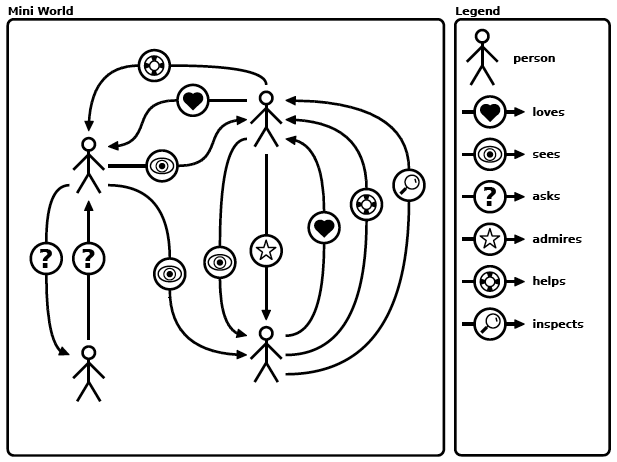 |
| ID |
ACE |
MLL |
| 1a− |
If X helps Y then Y helps X. |
helps IsSymmetric |
| 1b+ |
If X asks Y then Y asks X. |
asks IsSymmetric |
| 2a+ |
If X sees Y then Y does not see X. |
sees IsAsymmetric |
| 2b− |
If X asks Y then Y does not ask X. |
asks IsAsymmetric |
| 3a+ |
If X sees somebody who sees Y then X sees Y. |
sees IsTransitive |
| 3b− |
If X loves somebody who loves Y then X loves Y. |
loves IsTransitive |
| 4a+ |
If X admires Y then X sees Y. |
admires SubRelationOf sees |
| 4b− |
If X sees Y then X admires Y. |
sees SubRelationOf admires |
| 5a+ |
If X inspects Y then X helps Y. |
inspects SubRelationOf helps |
| 5b− |
If X helps Y then X inspects Y. |
helps SubRelationOf inspects |
| 6a− |
If X helps Y then Y admires X. |
helps SubRelationOf inverse admires |
| 6b+ |
If X loves Y then Y sees X. |
loves SubRelationOf inverse sees |
| 7a+ |
If X loves Y then X does not admire Y. |
loves DisjointWith admires |
| 7b− |
If X admires Y then X does not see Y. |
admires DisjointWith sees |
| 8a− |
If X sees Y then Y does not love X. |
sees DisjointWith inverse love |
| 8b+ |
If X admires Y then Y does not see X. |
admires DisjointWith inverse sees |
| 9a− |
If X admires Y then X sees Y. If X sees Y then X admires Y. |
admires EquivalentTo sees |
| 9b+ |
If X loves Y then X helps Y. If X helps Y then X loves Y. |
loves EquivalentTo helps |
| 10a− |
If X inspects Y then Y sees X. If Y sees X then X inspects Y. |
inspects EquivalentTo inverse sees |
| 10b+ |
If X admires Y then Y inspects X. If Y inspects X then X admires Y. |
admires EquivalentTo inverse inspects |
|
This ontograph and its statements are structurally equivalent to 4C.
| Ontograph (png, pdf, odg) |
Statements |
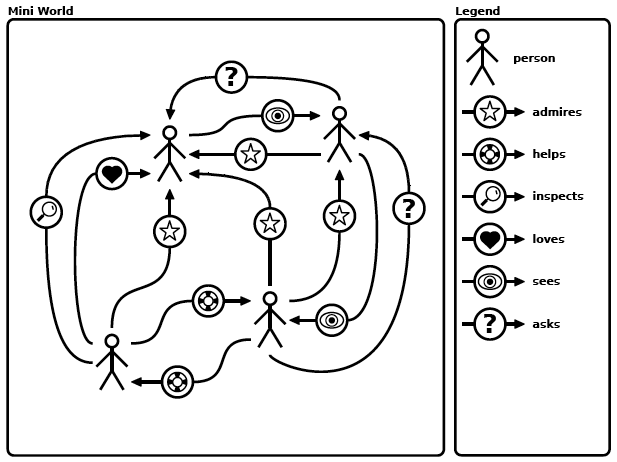 |
| ID |
ACE |
MLL |
| 1a+ |
If X helps Y then Y helps X. |
helps IsSymmetric |
| 1b− |
If X admires Y then Y admires X. |
admires IsSymmetric |
| 2a+ |
If X asks Y then Y does not ask X. |
asks IsAsymmetric |
| 2b− |
If X helps Y then Y does not help X. |
helps IsAsymmetric |
| 3a+ |
If X admires somebody who admires Y then X admires Y. |
admires IsTransitive |
| 3b− |
If X sees somebody who sees Y then X sees Y. |
sees IsTransitive |
| 4a− |
If X sees Y then X admires Y. |
sees SubRelationOf admires |
| 4b+ |
If X inspects Y then X admires Y. |
inspects SubRelationOf admires |
| 5a+ |
If X asks Y then X admires Y. |
asks SubRelationOf admires |
| 5b− |
If X admires Y then X asks Y. |
admires SubRelationOf asks |
| 6a− |
If X loves Y then Y admires X. |
loves SubRelationOf inverse admires |
| 6b+ |
If X sees Y then Y admires X. |
sees SubRelationOf inverse admires |
| 7a− |
If X admires Y then X does not inspect Y. |
admires DisjointWith inspects |
| 7b+ |
If X sees Y then X does not admire Y. |
sees DisjointWith admires |
| 8a+ |
If X asks Y then Y does not admire X. |
asks DisjointWith inverse admires |
| 8b− |
If X admires Y then Y does not see X. |
admires DisjointWith inverse sees |
| 9a+ |
If X loves Y then X inspects Y. If X inspects Y then X loves Y. |
loves EquivalentTo inspects |
| 9b− |
If X asks Y then X admires Y. If X admires Y then X asks Y. |
asks EquivalentTo admires |
| 10a− |
If X loves Y then Y admires X. If Y admires X then X loves Y. |
loves EquivalentTo inverse admires |
| 10b+ |
If X asks Y then Y sees X. If Y sees X then X asks Y. |
asks EquivalentTo inverse sees |
|
This ontograph and its statements are structurally equivalent to 4B.
| Ontograph (png, pdf, odg) |
Statements |
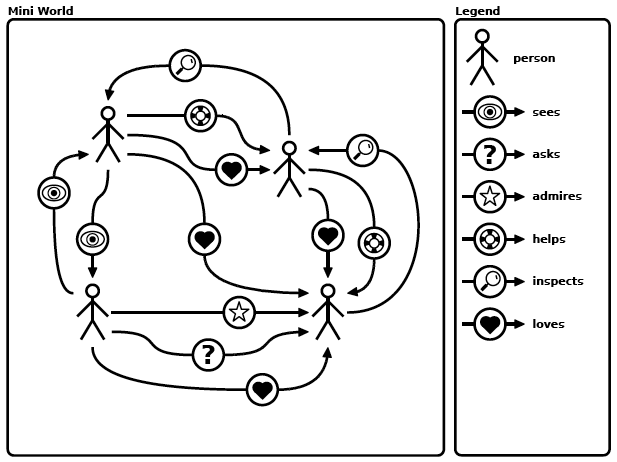 |
| ID |
ACE |
MLL |
| 1a+ |
If X sees Y then Y sees X. |
sees IsSymmetric |
| 1b− |
If X loves Y then Y loves X. |
loves IsSymmetric |
| 2a+ |
If X helps Y then Y does not help X. |
helps IsAsymmetric |
| 2b− |
If X sees Y then Y does not see X. |
sees IsAsymmetric |
| 3a+ |
If X loves somebody who loves Y then X loves Y. |
loves IsTransitive |
| 3b− |
If X inspects somebody who inspects Y then X inspects Y. |
inspects IsTransitive |
| 4a− |
If X inspects Y then X loves Y. |
inspects SubRelationOf loves |
| 4b+ |
If X asks Y then X loves Y. |
asks SubRelationOf loves |
| 5a+ |
If X helps Y then X loves Y. |
helps SubRelationOf loves |
| 5b− |
If X loves Y then X helps Y. |
loves SubRelationOf helps |
| 6a− |
If X admires Y then Y loves X. |
admires SubRelationOf inverse loves |
| 6b+ |
If X inspects Y then Y loves X. |
inspects SubRelationOf inverse loves |
| 7a− |
If X loves Y then X does not ask Y. |
loves DisjointWith asks |
| 7b+ |
If X inspects Y then X does not love Y. |
inspects DisjointWith loves |
| 8a+ |
If X helps Y then Y does not love X. |
helps DisjointWith inverse loves |
| 8b− |
If X loves Y then Y does not inspect X. |
loves DisjointWith inverse inspects |
| 9a+ |
If X admires Y then X asks Y. If X asks Y then X admires Y. |
admires EquivalentTo asks |
| 9b− |
If X helps Y then X loves Y. If X loves Y then X helps Y. |
helps EquivalentTo loves |
| 10a− |
If X admires Y then Y loves X. If Y loves X then X admires Y. |
admires EquivalentTo inverse loves |
| 10b+ |
If X helps Y then Y inspects X. If Y inspects X then X helps Y. |
helps EquivalentTo inverse inspects |
|
This is the questionnaire that the participants had to fill out after the experiment:
- Questionnaire, English (pdf, odt)
- Questionnaire, German (pdf, odt)
